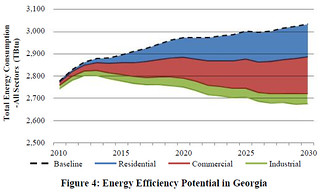 If Europe can do it, the U.S. can do it.
And we know
Georgia can get a third of its power from wind,
and even Spain is north of Mississippi, Alabama, Georgia, and Florida,
which have a lot more sun for solar power than anywhere in Europe.
Solar power
is already winning, even in Georgia.
Let’s help it win even faster, plus wind.
If Europe can do it, the U.S. can do it.
And we know
Georgia can get a third of its power from wind,
and even Spain is north of Mississippi, Alabama, Georgia, and Florida,
which have a lot more sun for solar power than anywhere in Europe.
Solar power
is already winning, even in Georgia.
Let’s help it win even faster, plus wind.
PR from Potsdam Institute for Climate Impact Research (PIK) 16 January 2014, EU could cut emissions by 40 percent at moderate cost,
The costs of achieving a more ambitious EU climate target are estimated to be moderate. Upscaling greenhouse-gas emissions reduction from the current 20 percent by 2020 to 40 percent by 2030 would be likely to cost less than an additional 0.7 percent of economic activity.
And that apparently doesn’t count the additional economic activity that would be produced by all those wind and solar deployments, not to mention related activities like electric cars. This is actually a pessimistic study, because it doesn’t account for such likely positive corollaries.
Many options to choose from—wind power could expand sevenfold
Options explored by the study to reach the EU climate target range from renewable energies to nuclear energy and energy-efficiency increases. “There’s a wide choice for decision-makers, depending on their preferences, so that’s a good thing,” says Detlef van Vuuren of the PBL Netherlands Environmental Assessment Agency and Utrecht University. “Still, most model calculations optimizing the change of the electricity system project energy from biomass to expand threefold, and from wind even sevenfold by 2050.” This would have to be reflected in a potential future EU target on renewable energy.
 Notice what the study does not propose:
fracked “natural” gas
such as the
methane Sabal Trail Transmission
proposes to gouge in a yard-thick pipeline on a hundred-foot right of way
through our wetlands and under our rivers into our fragile drinking-water
Floridan Aquifer.
Notice what the study does not propose:
fracked “natural” gas
such as the
methane Sabal Trail Transmission
proposes to gouge in a yard-thick pipeline on a hundred-foot right of way
through our wetlands and under our rivers into our fragile drinking-water
Floridan Aquifer.
The study does propose biomass, which is a bad idea.
We don’t need
 that Waycross wood pellet plant blowing up to feed bits of our
south Georgia pine forests to an English wood burner that also blows up.
Nothing’s perfect, but at least with this study somebody is trying
to examine what to do to stop climate change by switching to renewable energy.
that Waycross wood pellet plant blowing up to feed bits of our
south Georgia pine forests to an English wood burner that also blows up.
Nothing’s perfect, but at least with this study somebody is trying
to examine what to do to stop climate change by switching to renewable energy.
One remarkable finding is that Europe could do without relying on the much debated and as yet unproven technology of sequestering CO2 from power plant emissions and injecting it into the ground. This is a new result compared to the Roadmap study.
Take that, Kemper Coal, which has already caused missed earnings, stock price drops, and analyst downgrades for Southern Company. And so much for SO’s Plant Vogtle nuke boondoggle; there’s no need for nukes to cut emissions. Even Warren Buffett is moving from nuclear to wind.
Nonetheless, ‘Carbon Capture and Storage’ (CCS) would be needed to achieve an affordable worldwide transformation.
 Or would it?
Simply
switching to LED lighting
would make a big difference,
and
getting on with
conservation and efficiency
would also make a big difference.
Actually getting on with it;
not
the squirelled definition Southern Company still uses.
Or would it?
Simply
switching to LED lighting
would make a big difference,
and
getting on with
conservation and efficiency
would also make a big difference.
Actually getting on with it;
not
the squirelled definition Southern Company still uses.
 And then there’s the shiny elephant in the room:
solar power, which is booming in North Carolina,
just out of Southern Company’s restrictive reach.
The late John Blackburn already demonstrated back in 2010 that
North Carolina can be powered with sun, wind, water, and less methane
than it uses now.
Georgia can do the same.
And then there’s the shiny elephant in the room:
solar power, which is booming in North Carolina,
just out of Southern Company’s restrictive reach.
The late John Blackburn already demonstrated back in 2010 that
North Carolina can be powered with sun, wind, water, and less methane
than it uses now.
Georgia can do the same.
This study isn’t perfect, but it demonstrates that actually studying
energy generation and emission issues leads to solutions that are
actually quite good.
 Which is way better than
silly diatribes about how we can’t do it without massive
downgrades in living conditions.
Actually, green solar power is winning,
and this new study shows that with wind we can indeed convert the world
to renewable energy and cut emissions enough to greatly affect climate change.
Which is way better than
silly diatribes about how we can’t do it without massive
downgrades in living conditions.
Actually, green solar power is winning,
and this new study shows that with wind we can indeed convert the world
to renewable energy and cut emissions enough to greatly affect climate change.
Let’s help the sun rise on Georgia, the southeast, and the world!
-jsq
Short Link: